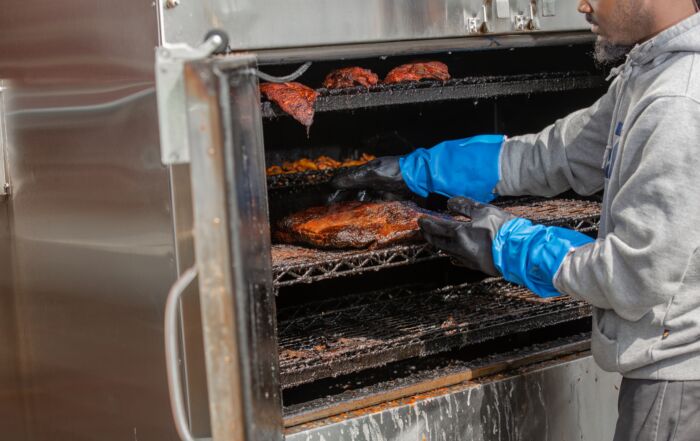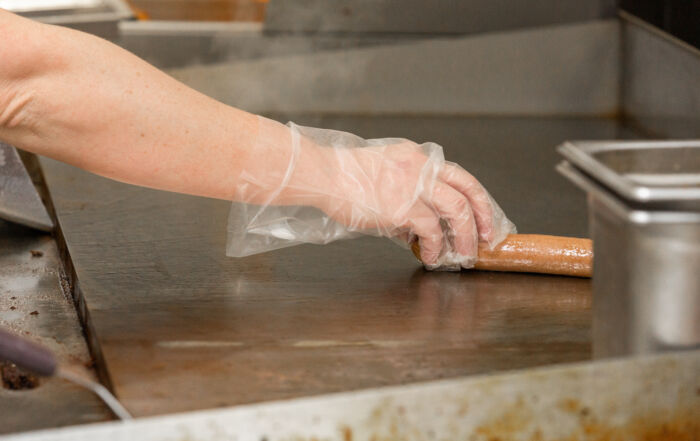Produce Safety: Special Considerations
In our last blog, I talked about general produce safety. Today, I want to talk about some special products—melons, tomatoes, leafy greens, and sprouts. These are all foods that have a history of bacterial contamination leading to foodborne illness. I also want to discuss salad bars because they have some special risks.
Melons. Cantaloupe is the melon of most concern because it has a webbed rind, and bacteria are easily trapped in that webbing resulting in contamination of the meat of the melon. Many people (maybe some of your staff) think that they eliminate any hazard because they cut away the rind—but that is not the case. In fact, some of our observational research showed staff routinely skipping the wash step for many vegetables with inedible peel. Cutting a knife through may transfer bacteria. Using the cutting board may result in cross contamination. To minimize risk, here are best practice recommendations:
- Avoid using melons that have visible signs of damage, decay, or cracking. This may indicate that bacteria has migrated into the meat of the melon.
- Wash the melon under running water to remove surface dirt, then scrub with a clean produce brush before cutting.
- Store cut melons in a refrigerator at 41oF or below.
- Discard cut melons after 4 hours if they have been held above 41oF or if the temperature of the product exceeds 70° F.
- Date mark refrigerated cut melons to indicate that they must be used within 7 days.
Tomatoes. Tomatoes can be a concern because bacteria can enter the fruit at the stem end. Here are some best practices to minimize risk:
- Receive fresh-cut tomatoes at 41oF or below. Whole tomatoes can be delivered at room temperature.
- Reject delivery of whole tomatoes that have excessive cracks, cuts, or other damage.
- Wash tomatoes with water that is about 10oF warmer than the internal temperature of the tomato. This will prevent bacteria from entering the interior of the tomato during washing.
- Cut away any damaged areas (bruises, cuts, cracks, etc.). Do not use tomatoes that have a lot of damage.
- Hold tomatoes at 41oF or below after cutting or slicing.
- Date mark refrigerated cut tomatoes to indicate that they must be used within 7 days.
- Do not store cut tomatoes in direct contact with ice or water because they could become contaminated.
Leafy greens. Leafy greens, both pre-cut and unprocessed forms, have been associated with a number of foodborne illness outbreaks. Leafy greens includes all types of lettuce, cabbage, spinach, kale, arugula, and chard. Herbs (such as cilantro and parsley) are not included in the category of leafy greens. Monitor food recalls and follow guidance provided. Practically, remove any decayed or damaged greens from whole heads of greens and wash thoroughly under running water. Remember, you don’t need to rewash greens that are labeled “ready-to-eat”, “washed”, or “triple washed”.
Sprouts. There have been a number of foodborne illness outbreaks due to various kinds of sprouts. The Food and Drug Administration (as well as your FoodHandler bloggers!!) has advised all consumers not to eat raw sprouts as a way to reduce the risk of foodborne illness. All sprouts should be cooked thoroughly before eating. There are suppliers who sell sprouts that have undergone special processing prior to delivery. If sprouts are on your menu, consider purchasing in this form. This recommendation is especially critical for children, pregnant women, the elderly, and people with weakened immune systems. So, if you are working in an educational facility where the children are growing sprouts as part of the curriculum, speak up and advise the teachers of this risk!
Salad Bars. Salad bars are a special concern—in fact, I prefer to avoid them even though they usually offer a great variety of fresh and beautiful vegetables and fruit. But in addition to that, I see all the dirty hands, and sniffly noses that pass by that salad bar, not to mention the service utensils that often end up in the pan and are dug out by a helpful customer! There are some best practices to follow when providing a salad bar in your foodservice operation:
- Protect food from contamination with effective sneeze guards or food shields. These are typically about 14-18 inches above the food, but placed to minimize opportunities for contamination from sneezing and other human contact. Think about your target audience and purchase guards in appropriate dimensions.
- Provide utensils (spoons, spoodles, tongs, ladles, etc.) to minimize bare hand contact with food. Change utensils often (at least every hour).
- Set up the salad bar as close to service time as possible. You want to minimize the time food is left on the salad bar.
- Use salad bars that control temperature (those with cold wells, insulated, etc.). You may use ice or ice sheets to aide in maintaining cold temperatures. The goal is to keep food at 41oF or below. Remember, never place food in direct contact with ice. Alternatively, Time as a Public Health Control (TPHC) may be allowed in your state. For more information, check the FDA Food Code or read Cathy’s July blog.
- Take and record food temperatures on the salad bar every 30 minutes.
- Clean up spills using a clean and sanitized wiping cloth.
- Label salad dressings and other food items to minimize the “need” for someone to taste and alert if there is the presence of one of the key allergens.
- Add new containers of food product, rather than adding food to existing containers. If a menu item has limited popularity, adjust the pan size and amount of food presented to avoid excessive waste.
- Discard cut produce that has not been kept at 41oF or below after 4 hours. Assign an employee to supervise the salad bar—watching out for situations where food may be contaminated, checking on use of utensils, helping those who may need assistance, etc.
- While items can be stored for service in the future if temperatures have been controlled properly, our advice is to discard all food placed on the salad bar at the end of the service period. This is a caution just in case customers have contaminated the product. To minimize waste, monitor popularity of items and select an appropriate size pan for service.
You and your employees play a key role in mitigating food safety risks related to fresh produce. Make sure your SOPs are up-to-date and train employees on implementing SOPs. This will allow everyone to enjoy the fresh fruits and vegetables of the season.
READ MORE POSTS
Turn your Health Inspector into your Food Safety Ally
For many foodservice operators, keeping up with evolving regulations can feel like chasing a moving [...]
Time and Temperature: Why 41°F to 135°F?
In one of my last blogs, I mentioned the temperature danger zone, or TDZ, as [...]
Maintaining Food Safety Standards Amid Seasonal Turnover
Across the country, summer seems to bring on more than just an influx of business [...]
When Temperatures Rise, Keep Food Safety Top of Mind
Summer brings a welcome increase in business for many restaurants, catering services, and event venues. [...]











